
Call them "agglets", "aglettes", "aiglets", or "those hard things at the end of my shoe laces", aiguillettes are an important finishing touch to the laces of any laced garment.
The aiguillettes at the end of your shoelace are usually molded-on or heat-shrunk plastic, nylon, or the same synthetic fiber as your lace, heated and molded into a long, needle-like lacing tool. (The word "aiguillette" comes from the French word aiguille, "needle".) For good or ill, plastics and nylons didn't exist until the 20th Century. Aiguillettes have been around somewhat longer -- there are examples that date back at least to the 16th Century (1), if not earlier.
On these pages, I show how to create an aiguillette that will serve for late-16th through mid-17th Century garments (2). This technique may apply to earlier and later periods as well, but I have no documentation to prove it.

You will need the following tools and materials:
You may be able to get by with only one of the pairs of pliers, but so far I've that having two pair of pliers is very useful when you get down to the tight work.
Additionally, you may wish to use a narrow metal cylinder -- such as a Size 1 or 2 (US; UK/Canadian 12 or 13; metric 2.25-2.75mm) knitting needle or the shaft of a traditional steel crochet hook (US sizes 00 through 14; metric sizes below 3.50mm) as an initial mold from which to form the aiguillette.
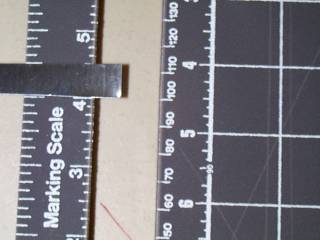
Unless you're trying to drive your lace through a wad of thick, heavy fabrics, your finished aiguillette will probably only need to be about 1/2" (1.25 cm) long. Cut a strip of metal 1/2" (1.25 cm) wide, or as wide as you need the finished aiguillette to be.
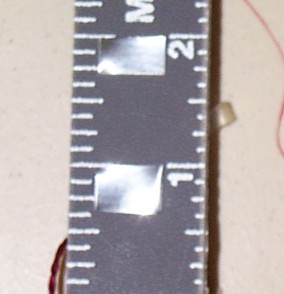
Next, cut a length from that metal strip wide enough to fit all the way around your cord, plus a little bit of overlap. So far, I've only done aiguillettes for lucet cord made from DMC #3 perle cotton and DMC #5 perle cotton. For #5 cotton, I find that a 1/4" (.625 cm) wide strip is sufficient; for #3 cotton, I find I need 3/8" (1.0 cm). The process is the same for aiguillettes for other sizes of cords and ribbons; you'll have to experiment until you get the right size for your ribbon or cord.
We'll call these rectangles "aiguillette blanks" for now. Pretty soon they'll be bona fide aiguillettes.
Take the round-nose pliers and grasp one of the side edges of the aiguillette blank. Make sure you have the entire length of the side (or as much as your pliers will allow). Bend in the side about 90 degrees, until the end of blank looks roughly "J" shaped or "L" shaped (see center of photo below).
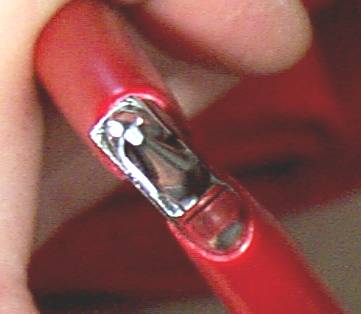
Next, do the same on the other side edge, until the edge of the blank looks "U" shaped (see center of photo below).
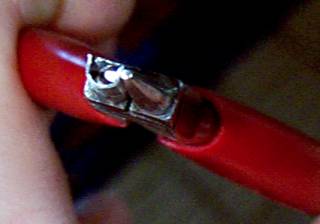
Then, carefully crimp each side in a bit -- one slightly more than the other -- until you have something which, end-on, looks like an open link in a chain (see photo below).
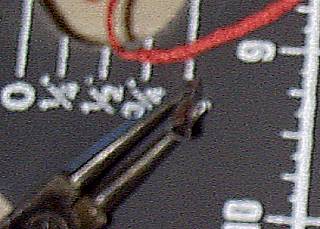
Alternatively, you might want to mold the aiguillette blank around a small-sized knitting needle or the shank of a traditional steel crochet hook, again, crimping until the edges almost, but not quite, touch.
Next, insert the cord into the half-formed aiguillette. You can do this by threading the leading/trailing thread through the blank, or by lining up the cord over the blank's long opening, and pulling hard on both ends of the cord while pushing up on the blank.
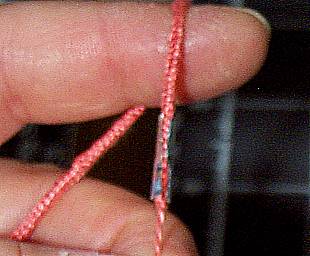
Finish the aiguillette by crimping down one side at a time, overlapping these sides if they meet.
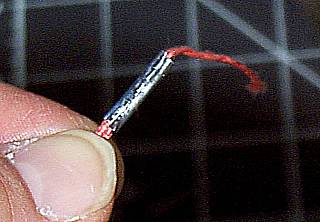
You may want to clip the leading thread, giving your lace end a clean finish.
Home Depot -- Tools, Metal Flashing
Fire Mountain Gems -- Beading and Jewelry Supplies, Tools
A. C. Moore craft supplies